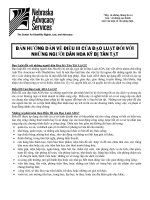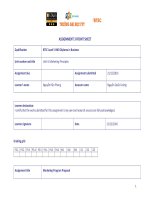Unit 24 ULC 1 of 2 assignment brief
Bạn đang xem bản rút gọn của tài liệu. Xem và tải ngay bản đầy đủ của tài liệu tại đây (921.05 KB, 6 trang )
Higher Nationals
Assignment Brief – BTEC (RQF)
Higher National Diploma in Business (Business Management)
Student Name /ID Number
Unit Number and Title
Unit 24: Understanding and Leading Change
Academic Year
2022-23
Unit Assessor
Aung Kyaw Oo
Assignment Number and Title
ULC1: Drivers of Change and Organisational Impact (1 of 2)
Issue Date
22nd September, 2022
Submission Date
4th November, 2022
IV Name
Date
Submission Format:
The submission is in the form of an individual written report. This should be written in a concise,
formal business style using single spacing and font size 12. You are required to make use of headings,
paragraphs and subsections as appropriate, and all work must be supported with research and
referenced using the Harvard referencing system.
Please also provide a reference list using the Harvard referencing system. The recommended word
limit is 2,000–2,500 words, although you will not be penalised for exceeding the total word limit.
Pearson Education 2018
Higher Education Qualifications
Assignment Brief
Unit Learning Outcomes:
LO1 Produce a comparative analysis of the different types and drivers of change in business
LO2 Evaluate the impact of change on organisational behaviour
Assignment Brief and Guidance:
CASE STUDY
1: VINAMILK
Introduction
COVID-19 is a harsh test for businesses and the whole economy which compels companies to
adapt and change to not only survive but also recover and grow stronger as soon as the pandemic is
under control.
Each business will have a different way of solving this problem. At a typical large-scale enterprise
like Vinamilk, dual goals (stabilise production and prevent the disease) are implemented based on
three key spearheads: Governance, Technology and People. Vinamilk has implemented a series of
change management to achieve these goals.
Flexible management for speedy response
For most businesses, even short-term production plans are usually drawn at least six months in
advance. However, continuous outbreaks of COVID-19 have changed this significantly.
According to Vinamilk’s CFO Le Thanh Liem, businesses had to change their planning from a 6month or 1-year plan to a less than 3-month plan. This change is necessary for this pandemic
situation. The management board must closely monitor and regularly update the market situation to
make timely decisions.
For example, at the initial stage of the pandemic in Vietnam, Vinamilk had to find ways to reduce
inventory to optimise cash flow. But at the time when the disease intensified, disrupting the supply
chain and causing input materials to be in short supply, Vinamilk adjusted its strategy to increase
inventories to promptly supply production activities.
"If keeping inventory at a normal level, it will not meet the plan implementation of the next quarter,"
Liem said.
In addition, Vinamilk has taken advantage of its nationwide production and distribution system to
stabilise production even when some localities had to implement social distancing measures.
Technology increases flexibility
One of the most profound and obvious impacts of COVID-19 is forcing businesses to move “from
offline to online”. At this time, technology comes to the fore in ensuring smooth business operations.
At Vinamilk, the employment of technology and investment in digital transformation has been
implemented for many years.
For example, the ERP system (enterprise resource planning) was employed 15 years ago which
helped facilitate sales and distribution activities, improving business efficiency. The cashless
payment system also helped Vinamilk’s payment system run smoothly.
Vinamilk’s factories and farms all apply automation and 4.0 technology, ensuring systematic and
remote management.
"Vinamilk's supply chain operates entirely on the information technology system, connecting from
the input - the purchase of raw materials - to the final output - the product to the consumer,"
Vinamilk’s representative said.
The company also equips technologies, tools and software to support communication and remote
work including e-Office, online browser system, solutions to help employees access company data
from home and digital signatures to ensure smooth operation in the company and with partners even
during the "work-from-home" time.
People - the decisive factor
Confronting COVID-19, human issues have become more important than ever. The company and
people must implement changes. The critical issue at this time is to ensure the health and safety of
employees to maintain stable business and production amid the pandemic.
From the beginning of 2020, Vinamilk has established a professional support committee for COVID19 prevention and control, disseminating information and guiding employees to comply with the
preventive measures while being online 24/7 to support problems related to the disease. The
company also provides employees with preventive tools and nutritional products.
In addition, Vinamilk also makes employees feel secure to work with full salary and welfare payment
policy; enhancing support for employees at “three on-site” units; and proactively supporting
employees in testing and vaccination.
Braving challenges, Vinamilk still rose six notches to 36th position in the world’s Top 50 dairy
producers by total sales in the 2021 ranking by UK-based Plimsoll Publishing Ltd. The company also
appeared in Brand Finance's Top 10 Most Valuable Milk Brands in the world with a valuation of 2.4
billion USD.
Even when the pandemic is under control, the market picture will never return to the way it was
before. Businesses need not only strength and endurance, but also flexibility and sensitivity to find
development directions when the economy returns to "new normal". Vinamilk has implemented the
right changes through flexible management, speedy response, technology and people.
2: VINFAST
Introduction
Established in 2017, VinFast is a private automotive manufacturer headquartered in Vietnam. The
company is a member of the Vingroup conglomerate, founded by Phạm Nhat Vuong. VinFast’s
state-of-the-art, 90% automated manufacturing complex in northern Vietnam is one of the largest in
Southeast Asia.
It is the first Vietnamese car brand to expand into global markets as well as the first Vietnamese car
brand to expand into producing Electric Vehicles (EVs) such as electric cars and electric scooters.
Vinfast has invested $3.5 billion in the development of this project which has an annual production
capacity of 250,000 cars.
Changes in Business
VinFast also launched Vsmart-branded smart phones, running on Android in 2018. The
smartphones are part of an ecosystem of smart AI devices the group plans to launch to market. In
May 2021, Vinfast announced that it would cease the production of smartphones.
In 2018, Vingroup has announced its plan to become an international-standard technology-industryservice business in the future.
In March 2019, Vingroup acquired the e-wallet platform MonPay. In the same year, the South
Korean conglomerate SK Group bought a 6.1% stake in Vingroup for $1 billion.
On September 10, 2020, VinFast announced that a loss of VND 6.6 trillion ($284 million) in the first
half of the year.
On February 9, 2022, Nikkei, Japan-based world's largest financial newspaper, reported that
Vingroup, Vinfast's mother company, lost approximately $1.05 billion in 2021" at its manufacturing
segment last year due to sluggish sales of gasoline-powered cars at home and growing investments
in the emerging electric vehicle business.
Changes in Leadership
On July 27, 2021, parent Vingroup announced that Michael Lohscheller, the CEO of Opel, had been
appointed CEO of VinFast Global. Five months later, on December 27, 2021, it was announced that
Lohscheller had resigned the position and return to Europe due to personal reasons. Vingroup has
appointed Le Thi Thu Thuy, the incumbent Vice-Chair, as its new VinFast Global CEO.
Madam Thuy will take over the VinFast Global CEO position, managing VinFast’s operations and
driving the Vietnamese carmaker towards becoming a global electric vehicle brand. She will also
maintain her current position as the Vice Chairwoman of VinFast’s parent company, Vingroup.
Based in Vietnam, the Vingroup Vice Chairwoman will directly oversee VinFast’s business activities
in its current markets, including Vietnam, the US, Canada, France, Germany, and the Netherlands.
Madam Thuy will also lead market survey activities and expansions into other potential global
markets in the coming years.
Leadership at VinFast
Changes in leadership have significant impact on Vinfast. Nguyen Le (2017), in The Leader
business forum, analysed that Le Thi Thu Thuy, vice president of the corporation will also be one of
the important factors that Pham Nhat Vuong trusts to steer the ship of VinFast. Before joining
Vingroup in 2008, she had worked for Lehman Brothers for eight years.
These actions prove that VinFast is pursuing a top-down management style. This is the process of
upper management or the chief executive officer reaching independent conclusions that change or
improve the workplace or business systems.
These conclusions are then handed down to employees, who work to accomplish the goals on their
own or with other employees. Some lower-level managers may have input into how to accomplish
the end goal, but they may not have much authority to change policies without approval from the
highest level of management.
Quicker Response to Market Demand and Product Changes
Designed to be one of the world’s leading smart electric mobility companies, VinFast currently
produces several models of electric scooters and buses in Vietnam, and planned to launch three
new electric SUVs – VFe34, VFe35 and VFe36, class C, D and E respectively - in Vietnam, North
America and Europe in 2021 and 2022.
On December 25, 2021, Vinfast delivered the first batch of 100 VF e34 electric crossovers to
Vietnamese customers at VinFast's manufacturing complex in Hai Phong.The VF e34 marks
VinFast's first EV model and the first ever electric vehicle to be manufactured and sold in Vietnam.
Because the VFe34 was the first smart car and electric vehicle in Vietnam, it opened a new category
in the automotive industry. Agility and adaption were keys for success. VinFast conducted regular
customer surveys, which were used to quickly make changes to key messaging and to adjust which
channels were being used to drive the campaign. This ensured that all ads were engaging potential
customers with messages they connected to and on channels they preferred.
On January 6, 2022, reports emerged that VinFast plans to build new EV plants in Germany and the
United States as part of the company's plans to retire production of gas-powered vehicles and
transition fully to EVs by late 2022.
(Sources: www.vietnamplus.vn, www.vinfastauto.com, www.theleader.vn, www.wikipedia.org,
www.mmaglobal.com, ww.spectos.com, www.vneconomictimes.com, www.mckinsey.com)
ROLE:
You are training to become a business analyst in a large multinational organisation.
REQUIRED:
Using above case studies, compare the impact that large-scale change has had upon the
organisation’s strategy and operations. Use appropriate theory to inform your discussion.
Include evaluation on how the change will have affected behaviours within the businesses and,
using theory and models, propose measures that could be taken to minimise negative impact on the
businesses.
The submission is in the form of a comparative report and should include the following:
1. An introduction to the drivers and impacts of change and how it affects organisational strategy
2. An overview of the organisation case studies
3. A PEST/SWOT analysis to be undertaken for each case study to identify drivers of change
4. Analysis for each organisation on the impact of change and the effects it has upon the
organisation’s strategy and operations
5. Evaluate on how change will have affected leadership, individuals and team behaviour
6. Evaluate on how the impact of change was minimised, and the application of appropriate
models to manage process of change efficiently.
Recommended Resources
Textbooks
CAMERON, E. and GREEN, M. (2019) Making Sense of Change Management. 5th Ed.
London: Kogan Page.
DAWSON, P. and ANDRIOPOULOS, C. (2017) Managing Change, Creativity and
Innovation. 3rd Ed. London: Sage.
HODGES, J. and GILL, R. (2015) Sustaining Change in Organizations. London: Sage.
LEWIS, L. K. (2019) Organizational Change: Creating Change Through Strategic
Communication. Chichester: Wiley-Blackwell.
MEE-YAN, C-J. and HOLBECHE, L. (2015) Organization Development: a Practitioner's
Guide for OD and HR. London: Kogan Page.
NORTHOUSE, P. G. (2018) Leadership Theory and Practice. 8th Ed. London: SAGE.
PENDLETON, D. and FURNHAM, A. (2016) Leadership: All You Need to Know.London:
Palgrave Macmillan.
STANFORD, N. (2018) Organization Design: Engaging with Change. 3rd Ed.
London: Routledge.
Websites
www.businesstrainingworks.com
Business Training Works
Resources
(General reference)
www.managementtoday.com
Management Today
Leadership
News and industry articles
(General reference)
www.mindtools.com
Mind Tools
Leadership
Change Management
(General reference)
www.strategy+business.com
Strategy and Business
Leadership
(Articles)
Learning Outcomes and Assessment Criteria
Learning Outcome
Pass
Merit
Distinction
LO1 Produce a
comparative analysis of
the different types and
drivers of change in
business
P1 Review a range of
contemporary
examples of
organisational change
and their impact on
business operations.
M1 Analyse drivers for
change and the types
of organisational
change they have
affected.
LO1 and LO2
P2 Compare drivers for
change and their
influence on
organisational change.
LO2 Evaluate the
impact of change on
organisational
behaviour
P3 Analyse how
leadership and
individual behaviour in
organisations can be
affected by change.
M2 Critically evaluate
the long-term
implications of change
on organisational
behaviour.
P4 Evaluate measures
that can be taken to
minimise negative
impacts of change on
organisational
behaviour
Pearson Education 2018
Higher Education Qualifications
Assignment Brief
D1 Make justified
recommendations that
would minimise impact
of organisational
change on
organisational
behaviour.









